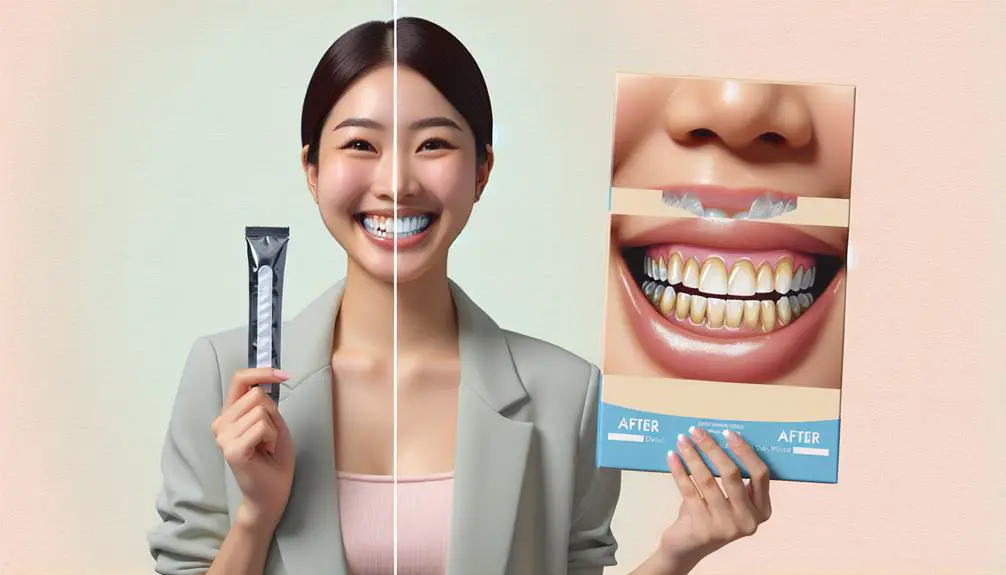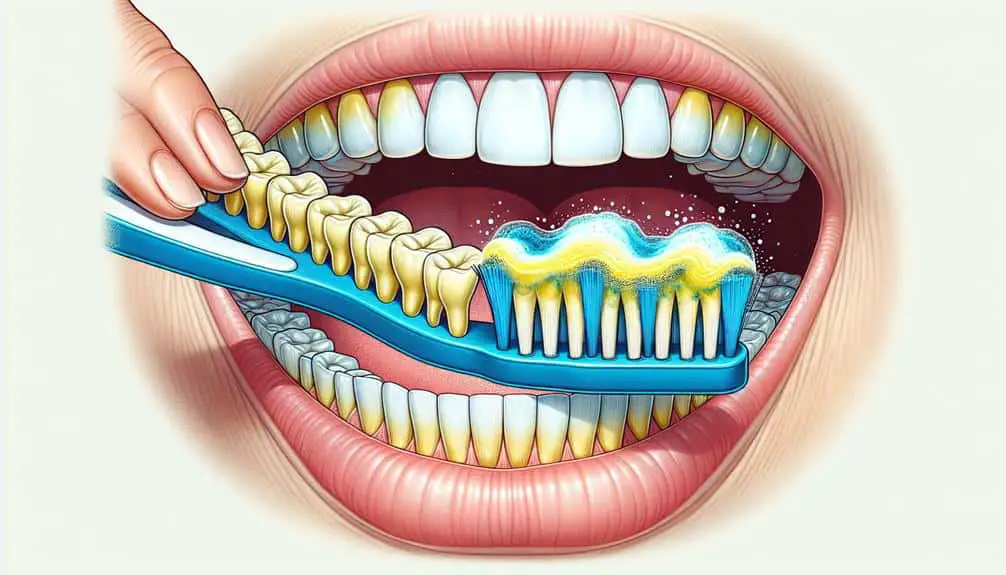When dealing with fluoride-stained teeth, select whitening strips designed for this issue. Guarantee even application for consistent results and check the recommended duration and whitening agent concentration. Opt for strips tailored to tackle fluoride stains effectively. Incorporate good oral hygiene practices and follow directions for best outcomes. Compare different products based on user reviews, cost, and active ingredients to find the best fit for you. Keep up with regular dental check-ups and daily oral care to maintain a bright smile. Additional insights on the top whitening strips await for a brighter, healthier smile.
Key Points
- Choose whitening strips designed for fluoride-stained teeth.
- Verify the whitening agent concentration for effectiveness.
- Consider user reviews and satisfaction rates for best results.
- Follow recommended application duration for optimal whitening.
- Look for strips with proven active ingredients for efficient stain removal.
Understanding Fluoride-Stained Teeth
If your teeth appear discolored due to excessive fluoride exposure, understanding the causes and effects of fluoride-stained teeth is essential for seeking appropriate treatment. Fluorosis, caused by excessive fluoride intake during tooth development, leads to enamel hypomineralization and discoloration. Prevention involves monitoring fluoride intake from various sources such as water, toothpaste, and supplements.
Excessive fluoride exposure disrupts the enamel formation process, resulting in white streaks, brown spots, or mottled patches on the teeth. The severity of staining is directly related to the amount of fluoride ingested during the formative years. To prevent fluorosis, it's vital to regulate fluoride consumption, especially in children whose developing teeth are more susceptible.
Maintaining ideal oral hygiene practices and consulting a dental professional for guidance on fluoride intake can help prevent the development of fluoride-stained teeth. Understanding the causes of fluorosis and taking proactive measures to limit fluoride exposure are key in preserving the natural whiteness of your teeth.
Choosing the Right Whitening Strips
Selecting the appropriate whitening strips for effectively treating fluoride-stained teeth requires careful consideration of their whitening agent concentration and application method. When choosing the right whitening strips, keep the following in mind:
- Strip Application: Look for whitening strips that are easy to apply evenly on the teeth to guarantee all surfaces receive proper treatment.
- Whitening Duration: Consider the recommended duration for wearing the strips. Some strips are designed for quick results with shorter wear times, while others may require longer sessions for best whitening effects.
- Whitening Agent Concentration: Check the concentration of the whitening agent in the strips. Higher concentrations may provide faster results but could also increase the risk of tooth sensitivity.
- Compatibility with Fluoride-Stained Teeth: Opt for whitening strips specifically formulated for addressing fluoride stains to maximize effectiveness and achieve desired results.
Tips for Effective Whitening Results
To enhance the effectiveness of whitening strips in treating fluoride-stained teeth, consider incorporating these proven tips for best results. When aiming for ideal whitening outcomes, focus on preventing future stains by avoiding or reducing the consumption of staining agents such as coffee, tea, and red wine. Additionally, maintaining good oral hygiene practices, like brushing and flossing regularly, can help prevent new stains from forming on your teeth.
Proper application of whitening strips is vital for achieving desired results. Before applying the strips, make sure your teeth are clean and dry to allow for better adhesion. Place the strips carefully, ensuring they cover the stained areas fully. Follow the recommended wearing time to avoid potential damage to your enamel while maximizing the whitening effects.
Best Whitening Strips Comparisons
When evaluating whitening strips, it's important to consider factors such as active ingredients, effectiveness, and user reviews to determine the best option for achieving whiter teeth.
Here are some key considerations for comparing whitening strips:
- Product Reviews: Before making a purchase, explore product reviews to gain insights from other users who've tried the whitening strips. Look for feedback on effectiveness, ease of use, and overall satisfaction to make an informed decision.
- Cost Comparison: Compare the cost of different whitening strips to make sure you're getting the best value for your money. Some brands may offer similar results at a lower price point, so it's important to weigh the cost against the benefits.
- Effectiveness: Look for whitening strips that contain proven active ingredients like hydrogen peroxide or carbamide peroxide, as these are known to effectively whiten teeth. Consider the concentration of these ingredients for best results.
- User Satisfaction: Consider the overall user satisfaction rate of the whitening strips. Products with higher user satisfaction levels are more likely to deliver the desired results.
Maintaining a Bright Smile
For maintaining a bright smile, prioritize consistent oral hygiene habits and regular dental check-ups to ensure peak dental health and whiteness. Effective oral hygiene practices include brushing your teeth at least twice a day with fluoride toothpaste, flossing daily to remove plaque and debris between teeth, and using mouthwash to eliminate bacteria and freshen breath. Additionally, consider incorporating whitening toothpaste into your routine to help sustain the brightness of your smile.
Dental care is essential for preserving the whiteness of your teeth. Schedule regular dental check-ups every six months for professional cleanings and to address any potential issues promptly. Your dentist can also provide guidance on whitening treatments and products tailored to your specific needs. Avoid habits like smoking and excessive consumption of staining beverages like coffee, tea, and red wine, as they can diminish the brightness of your smile. By following these recommendations, you can maintain a radiant smile and ideal oral health for years to come.
Frequently Asked Questions
Are Whitening Strips Safe to Use on Fluoride-Stained Teeth?
When using whitening strips on fluoride-stained teeth, safety concerns arise due to enamel sensitivity. Effectiveness varies, but long-term results can be maintained with proper care. Consult a dentist for personalized advice on safe usage.
Can Whitening Strips Completely Remove Severe Fluoride Stains?
You can try the best whitening strips, but for severe fluoride stains, they may not fully erase them. Alternative treatments like professional whitening might be necessary. Long term effects may vary, so consult a dentist.
How Long Should I Wait Before Seeing Results When Using Whitening Strips on Fluoride-Stained Teeth?
When using whitening strips on fluoride-stained teeth, you should wait around 1-2 weeks before seeing noticeable results. Track progress by comparing shade changes. Manage expectations by understanding that effectiveness varies based on individual stain severity and product strength.
Are There Any Specific Ingredients in Whitening Strips That Are Particularly Effective for Removing Fluoride Stains?
To effectively remove fluoride stains, look for whitening strips containing ingredients like hydrogen peroxide or carbamide peroxide. These components work by penetrating the enamel to break down the stains. Follow application tips carefully for best results.
Can Whitening Strips Be Used in Conjunction With Other Dental Treatments for Fluoride-Stained Teeth?
You can enhance fluoride-stained teeth by combining whitening strips with dental procedures. Cosmetic dentistry offers various treatments to boost the effects of whitening strips, providing a thorough approach for achieving a brighter, stain-free smile.



